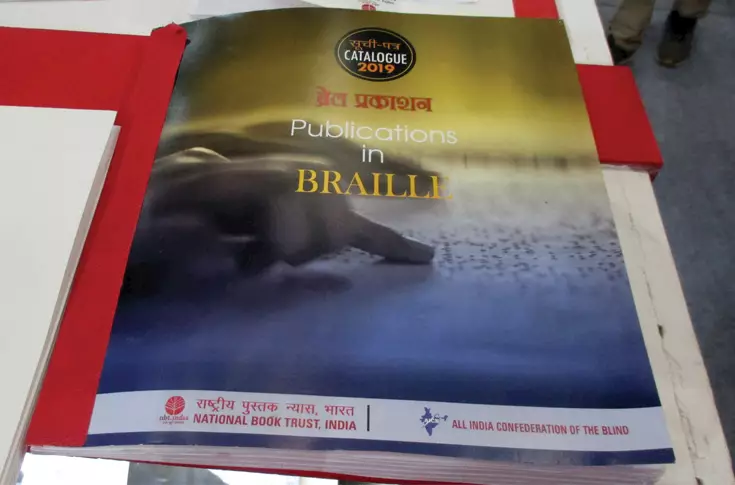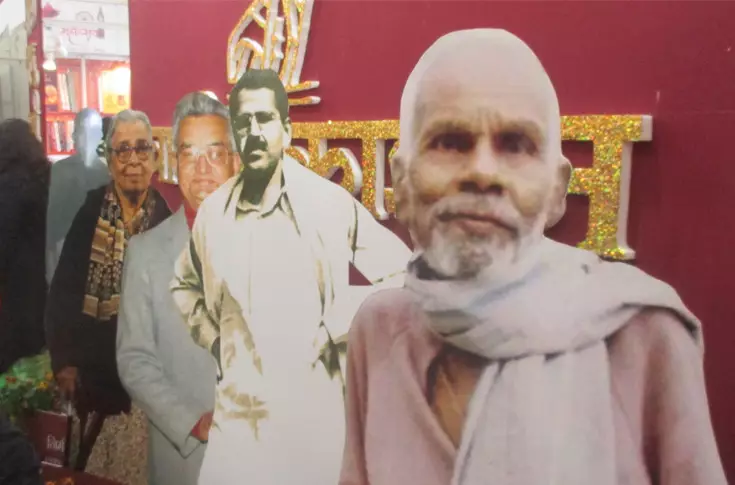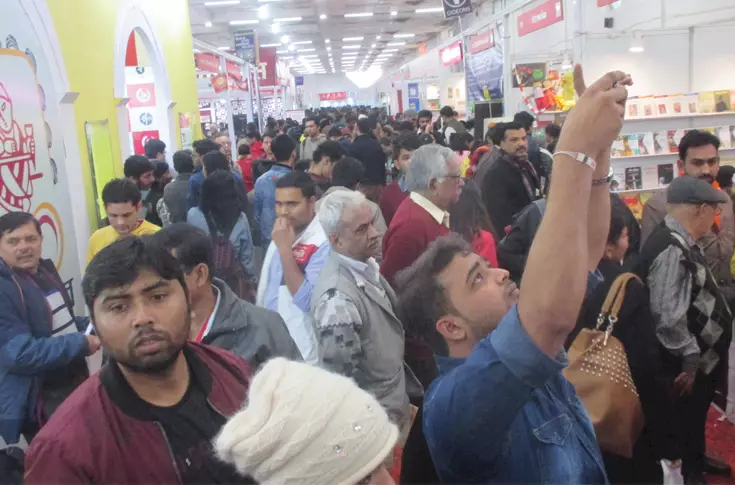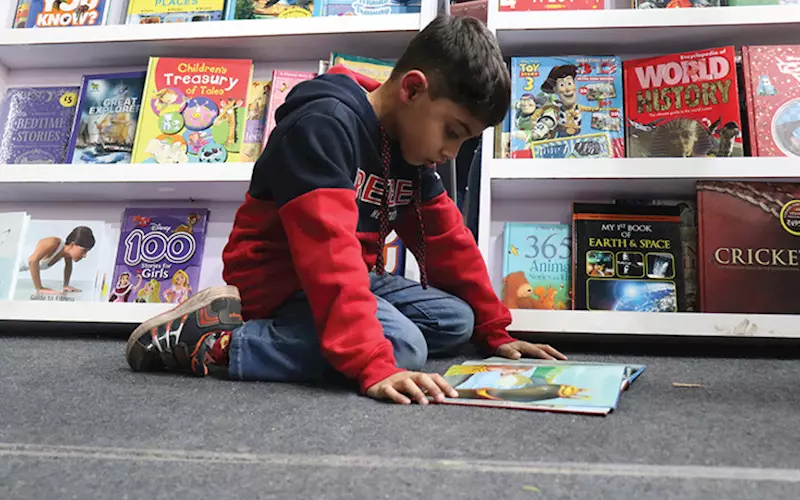Breaking language barriers at the World Book Fair 2019
Literary exchanges and books for all the readers, irrespective of languages and abilities, were the highlights of the 27th edition of New Delhi World Book Fair, held at the Pragati Maidan in New Delhi from 5 to 13 January 2019, reports Dibyajyoti Sarma
16 Jan 2019 | By Dibyajyoti Sarma
To be certain, the annual New Delhi World Book Fair (NDWBF) is neither Frankfurt, where it’s more business nor London, where it’s more books. NDWBF is its own thing, a mixture of both books and business, and a gathering of book lovers in the country’s capital. The 27th edition of the Fair was no exception with booksellers and book buyers crowding the halls at Pragati Maidan from 5 to 13 January 2019.
If NDWBF 2019 looked especially crowded this year, it’s because due to the ongoing construction at the Fair site, exhibition space was limited, and as a result, while a number of exhibitors did not even get to book their stalls, others were squeezed into smaller spaces. Still, visitor footfall was encouraging, not just in the Hindi language section, which always sees a better footfall, but also in the English trade section.
Inaugurating the event on 5 January, Prakash Javadekar, minister of human resource development, said that last year 12 lakh people visited the show. This year’s number should easily match this figure.
This year’s Guest of Honour country was Sharjah. Javadekar said, “More than two million Indians have made UAE their homes, which shows that the cultural ties between the two countries have grown over the years.
India-UAE collaborations
On the second day of the Fair, a discussion between Indian and UAE publishers during the seventh edition of CEOSpeak, a forum for dialogue in the publishing sector, saw the Emirati publishers underlining the need for translated works, and for Indian publishing to expand into Africa through Sharjah.
Ahmed Al Ameri, chairman, Sharjah Books Authority, said, “Sharjah is the gateway to Africa for Indian publishers,” adding, “Reading and literacy are the beating hearts of Sharjah.”

Sharjah was the Guest of Honour country at the Fair this year
He said while it takes 60 days to ship from India to Africa, it takes only two weeks from Sharjah, the UAE’s third largest emirate and a free-zone in the world for publishing. He also highlighted the importance of translations for cultural exchanges and cross-border collaborations. To highlight this, at the Sharjah pavilion in the Fair, it hosted 10 emerging litterateurs from UAE and a set of 57 books translated from Arabic to Hindi.
Dilip Chenoy, secretary general, FICCI, said that India is a USD 4.6 billion book market and the third largest English language print book publisher in the world, adding, “UAE accounts for a sprawling 37% of India’s total book exports to the Arab world.”
The forum also saw publishing stalwarts discuss literature for children and young adults, and brought forth the need to include them in forums like CEOSpeak. Both UAE and Indian publishers noted the need to give young readers myriad options and highlight the common challenges they face across geographic borders, rather than just trying to transmit values through the written word.
Vikrant Mathur, director, India & Asia Pacific, Nielsen Book, said the total trade market in India is worth Rs 24.0 billion and growing at a CAGR of 8.5%. Local languages trade books account for 44% of the market and English trade books 56%. He said within English trade books, the highest contribution is that of adult non-fiction at 45%, followed by adult fiction (30%) and children (25%). Hindi contributes maximum (35%) followed by Malayalam (9%) and Bengali (8%).
CEOSpeak was organised jointly by the Federation of Indian Chambers of Commerce and Industry (FICCI) and National Book Trust, India, the organiser of the book fair.
Books for differently-abled
The theme for NDWBF 2019 was ‘Books for readers with special needs’, and it was a timely initiative too as special books for the differently-abled remain a marginal publishing activity. The theme pavilion had an exhibit of around 50 books, including Braille editions, audio books, integrated print-Braille books, silent books, tactile books. On the occasion, NBT published a special catalogue of its books published in Braille, so that the large-sized book can be read by the visually-challenged. The book contains a list of 250 titles in Braille.

The theme of NDWBF 2019 was ‘Books for readers with special needs’
New Delhi Rights Table
For publishers, an important feature of the Fair is the New Delhi Rights Table. On its seventh edition, this year, the two-day event saw the participation of more than 60 publishers from India and abroad. The forum provides a platform to network and explores business opportunities together with publishers, right agents, authors, translators, and editors.
100 German must-reads
The German Book Office, New Delhi showcased ‘100 German Must-Reads’, a selection of volumes that has the power to change the reader’s view of Germany and Europe. Presented by Deutsche Welle, the ultimate list of German-language books translated into English, feature books such as Franz Kafka’s The Trial; Bertolt Brecht’s Threepenny Opera; Pascal Mercier’s Night Train to Lisbon and Cornelia Funke’s Inkheart, among others. The selection ranges from books published in 1901 (Thomas Mann’s Buddenbrooks) to 2016 (Phillip Winkler’s Hooligan).
The business of (self) publishing
In the last couple of years, largely thanks to Amazon’s self-publishing platform, self-publishing has become a legitimate publishing segment on its own, attracting readers, writers and solution providers. Chennai-based Notion Press, which calls itself ‘guided publishing platform,’ had the strongest presence at the fair. One of the fastest-growing self-publishing business in India, founded in 2012, with branches in Singapore and Malaysia, the company has published more than 4,000 books.
Then there were other names like Blue Rose, Zorba, and so on. The business looks so lucrative that even Nielsen has started offering services for independent publishers and self-published authors. The company helps writers and new publishers understand the book supply chain and guides them through the process from purchasing a publisher prefix and range of ISBNs to receiving your orders online and enhancing metadata to ensure wide reach.
There was Repro Books to take care of the printing and distribution aspect of books. Manipal Technologies, which offers a range of services to publishers, including print production, warehousing, end-to-end digital publishing and so on, also made its presence felt during the show. Also present was S Chand, one of the country’s biggest education publishers.

The Vani Prakashan stall had life-size cut outs of the prominent authors who passed away in 2018
Between Hindi and English
Over the years, English and Hindi publishing have been working to make books published in either language available into the other. For example, this year, journalist Ravish Kumar’s popular book of micro-fiction, Ishq Mein Seher Hona, published by Rajkamal, was translated into English and was published by Speaking Tiger. The same way, Rajkamal released the Hindi translation of Arundhati Roy’s novel The Ministry of Utmost Happiness during the Fair.

During the Fair, Rajkamal Prakashan Samuh released the Hindi translation of Arundhati Roy’s novel The Ministry of Utmost Happiness
However, the highlight of this literary exchange was the publication of the first English edition of the popular Hindi literary magazine Hans. The first edition of English translations of selected works from its earlier editions was unveiled during the show by author Mark Tully and novelist Mridula Garg, who spoke about the magazine’s illustrious history.

Author Mark Tully and novelist Mridula Garg during the release of the first English edition of the popular Hindi magazine Hans
The inaugural issues carry 13 stories published over five years between 1986 and 1990 in original Hans.
Rachna Yadav, managing director of the magazine and daughter of writer and former editor Rajendra Yadav said the English translations were an effort to expose audiences outside of the ‘Hindi belt’, especially in metro cities about the wealth of contemporary Hindi fiction.
The Hindi version of the magazine has a circulation of about 10,000 copies.
While Hindi publishers are doing their bit to translate kinds of literature from English and other languages into Hindi, it’s the English language publishers who are taking the momentum of Hindi publishing forward. Today, all major English publishers have a Hindi imprint. For example, last year, Penguin Random House India acquired Hind Pocket Books, one of the oldest Hindi language publishers in the country. Meanwhile, Oxford University Press has started publishing books in local languages, starting with Hindi and Bengali. This year, OUP had a separate stall to showcase its non-English books.
The latest among them is Niyogi Books, which, on 9 January, a day ahead of World Hindi Day, announced its latest imprint, Bahuvachan, dedicated to Hindi titles. “Through this new imprint, we are celebrating our state language, Hindi, which is also one of the most spoken languages in the world,” Trisha De Niyogi of Niyogi Books told reporters.

Visitors at the show














 See All
See All